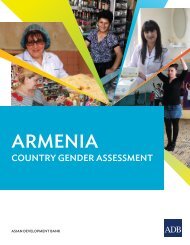Civic Activism as a Novel Component of Armenian Civil Society
English-3
English-3
You also want an ePaper? Increase the reach of your titles
YUMPU automatically turns print PDFs into web optimized ePapers that Google loves.
Appendix 6 Qualitative Data Indexing Scheme for the indexing scheme.<br />
Thus, the study is a mix <strong>of</strong> methods, intended to capture various, dynamic <strong>as</strong>pects <strong>of</strong><br />
contemporary <strong>Armenian</strong> civil society and placing them in the broader context <strong>of</strong> political culture.<br />
The remainder <strong>of</strong> the manuscript presents our findings, starting with a general discussion <strong>of</strong> the<br />
overall political culture, focusing particularly on <strong>as</strong>pects <strong>of</strong> political participation and<br />
information-gathering patterns.<br />
IV. <strong>Armenian</strong> Public Attitudes and Political Culture: Setting the Stage<br />
<strong>Armenian</strong> civic and political life h<strong>as</strong> gone through several ph<strong>as</strong>es: from the dramatic and<br />
unprecedented levels <strong>of</strong> mobilisation <strong>of</strong> the late 1980s and early 1990s to widespread cynicism<br />
and disengagement around the turn <strong>of</strong> the century. Some argue that civic and political<br />
participation is slowly recovering from a recession, citing the 2008 presidential elections <strong>as</strong> a<br />
sign <strong>of</strong> relatively successful social mobilisation (albeit an unsuccessful attempt at changing<br />
political leadership).<br />
As discussed in Chapter II, the landscape <strong>of</strong> <strong>Armenian</strong> civil society also seems to be<br />
changing: civic initiatives have been re-energising it since circa 2008. These youth-driven, social<br />
media-powered, issue-specific, loosely organised miniature social movements are the new form<br />
<strong>of</strong> protest and political participation, in addition to ‘traditional’ electoral mobilisation. There<br />
have been more than 30 such initiatives in Armenia since 2007, with roughly one-quarter <strong>of</strong><br />
those resulting in a victory for the activists. It remains to be seen whether and to what extent<br />
these movements will grow in scope.<br />
The new forms <strong>of</strong> social participation take place against the general backdrop <strong>of</strong><br />
<strong>Armenian</strong> political culture, which suffers from a post-communist syndrome <strong>of</strong> disengagement<br />
and cynicism towards the public sphere. These values and opinions, however, are not static and<br />
not necessarily shared by the various socio-economic and demographic groups present in<br />
<strong>Armenian</strong> society. To accurately <strong>as</strong>sess the odds <strong>of</strong> incre<strong>as</strong>ed participation in social movements<br />
and other forms <strong>of</strong> non-conventional political participation, a more detailed analysis <strong>of</strong> the trends<br />
and patterns <strong>of</strong> <strong>Armenian</strong> political culture is necessary. This chapter examines public opinion<br />
survey data (World Values Survey 1997 and 2011, Cauc<strong>as</strong>us Barometer 2008-2013 and other<br />
nationwide representative surveys) to examine social and political participation (both actual and<br />
potential) among the <strong>Armenian</strong> population, with a focus on age cohorts, gender differences, and<br />
other socio-demographic variables. It also highlights the use <strong>of</strong> social media by various groups.<br />
The aim <strong>of</strong> the chapter is to place <strong>Armenian</strong> civic initiatives in the context <strong>of</strong> the political culture<br />
in which they operate.<br />
The chapter examines secondary data on various types <strong>of</strong> political and civic participation<br />
in Armenia and contr<strong>as</strong>ts those data with data on Internet and social media use. The aim is to<br />
23



